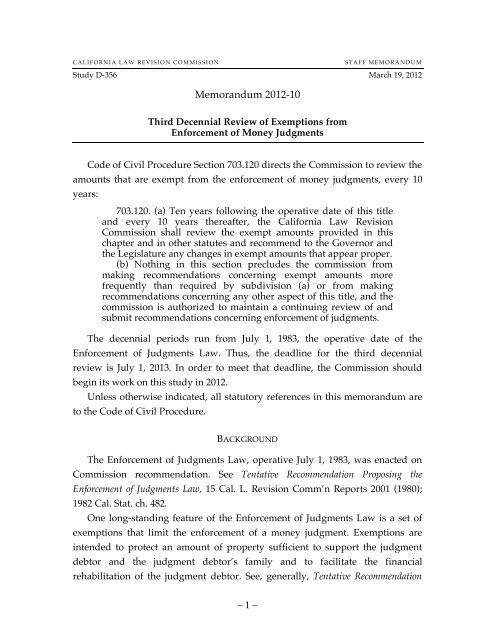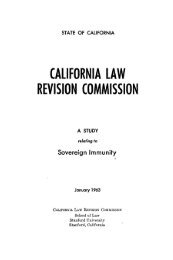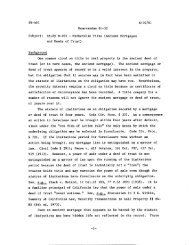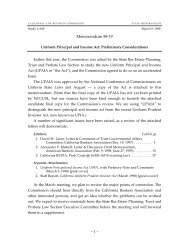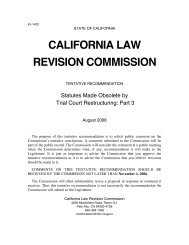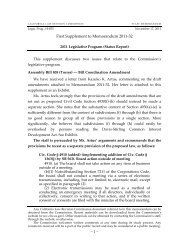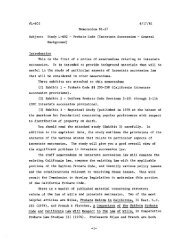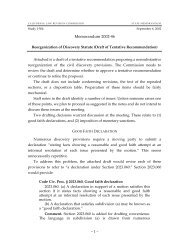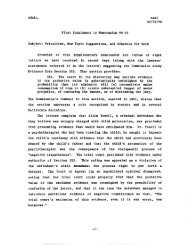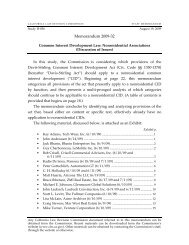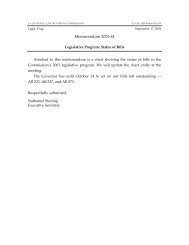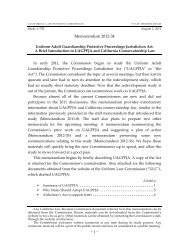Memorandum 2012-10 - California Law Revision Commission
Memorandum 2012-10 - California Law Revision Commission
Memorandum 2012-10 - California Law Revision Commission
Create successful ePaper yourself
Turn your PDF publications into a flip-book with our unique Google optimized e-Paper software.
CALIFORNIA LAW REVISION COMMISSION<br />
STAFF MEMORANDUM<br />
Study D-356 March 19, <strong>2012</strong><br />
<strong>Memorandum</strong> <strong>2012</strong>-<strong>10</strong><br />
Third Decennial Review of Exemptions from<br />
Enforcement of Money Judgments<br />
Code of Civil Procedure Section 703.120 directs the <strong>Commission</strong> to review the<br />
amounts that are exempt from the enforcement of money judgments, every <strong>10</strong><br />
years:<br />
703.120. (a) Ten years following the operative date of this title<br />
and every <strong>10</strong> years thereafter, the <strong>California</strong> <strong>Law</strong> <strong>Revision</strong><br />
<strong>Commission</strong> shall review the exempt amounts provided in this<br />
chapter and in other statutes and recommend to the Governor and<br />
the Legislature any changes in exempt amounts that appear proper.<br />
(b) Nothing in this section precludes the commission from<br />
making recommendations concerning exempt amounts more<br />
frequently than required by subdivision (a) or from making<br />
recommendations concerning any other aspect of this title, and the<br />
commission is authorized to maintain a continuing review of and<br />
submit recommendations concerning enforcement of judgments.<br />
The decennial periods run from July 1, 1983, the operative date of the<br />
Enforcement of Judgments <strong>Law</strong>. Thus, the deadline for the third decennial<br />
review is July 1, 2013. In order to meet that deadline, the <strong>Commission</strong> should<br />
begin its work on this study in <strong>2012</strong>.<br />
Unless otherwise indicated, all statutory references in this memorandum are<br />
to the Code of Civil Procedure.<br />
BACKGROUND<br />
The Enforcement of Judgments <strong>Law</strong>, operative July 1, 1983, was enacted on<br />
<strong>Commission</strong> recommendation. See Tentative Recommendation Proposing the<br />
Enforcement of Judgments <strong>Law</strong>, 15 Cal. L. <strong>Revision</strong> Comm’n Reports 2001 (1980);<br />
1982 Cal. Stat. ch. 482.<br />
One long-standing feature of the Enforcement of Judgments <strong>Law</strong> is a set of<br />
exemptions that limit the enforcement of a money judgment. Exemptions are<br />
intended to protect an amount of property sufficient to support the judgment<br />
debtor and the judgment debtor’s family and to facilitate the financial<br />
rehabilitation of the judgment debtor. See, generally, Tentative Recommendation<br />
– 1 –
Proposing the Enforcement of Judgments <strong>Law</strong>, 15 Cal. L. <strong>Revision</strong> Comm’n Reports<br />
2001, 2075-2<strong>10</strong>0 (1980); 1982 Creditors’ Remedies Legislation, 16 Cal. L. <strong>Revision</strong><br />
Comm’n Reports <strong>10</strong>01, <strong>10</strong>79-1<strong>10</strong>9 (1982).<br />
The Enforcement of Judgments <strong>Law</strong> includes two main sets of exemptions:<br />
the exemptions available when enforcing a money judgment (Section 704.0<strong>10</strong> et<br />
seq.; hereafter the “Section 704 general exemptions”) and an alternative set of<br />
exemptions that are only available in bankruptcy (Section 703.140(b); hereafter<br />
the “Section 703 bankruptcy exemptions”).<br />
Exemptions from Enforcement of Money Judgments<br />
There are three types of exemptions from the enforcement of a money<br />
judgment:<br />
(1) Exemptions that protect personal property without regard to the<br />
monetary value of the property. See Sections 704.020 (“ordinary and<br />
reasonably necessary” household furnishings, appliances,<br />
provisions, wearing apparel, personal effects), 704.050<br />
(“reasonably necessary” health aids, including prostheses and<br />
orthopedic appliances). Because those exemptions are not limited<br />
to a specified dollar amount, they are not subject to degradation in<br />
value as a result of inflation. Consequently, there is no need to<br />
review the “amounts” of these exemptions.<br />
(2) Exemptions that protect personal property up to a specified amount of<br />
value. See Sections 704.0<strong>10</strong> (motor vehicle), 704.030 (residential<br />
repair materials), 704.040 (jewelry, heirlooms, and works of art),<br />
704.060 (tools of a trade, business, or profession), 704.080 (directly<br />
deposited Social Security and public benefit payments), 704.090<br />
(inmate trust account), and 704.<strong>10</strong>0 (life insurance policy). The<br />
current dollar value for these exemptions can be found in the<br />
Exhibit.<br />
(3) The “homestead exemption,” which protects a specified portion of the<br />
value of real property under specified circumstances. See Section<br />
704.730.<br />
Some of the exemption dollar amounts are increased if the judgment debtor is<br />
married. See Sections 704.060 (tools of a trade), 704.090 (inmate trust account),<br />
704.<strong>10</strong>0 (life insurance policy). But the general rule is that married persons are<br />
not entitled to increased or doubled exemption amounts, regardless of whether<br />
one or both of the spouses are debtors and regardless of the separate or<br />
community nature of the property. See Section 703.1<strong>10</strong>(a).<br />
Exemptions in fixed dollar amounts have the virtue of certainty and they help<br />
prevent abuse that can occur where specific items of property are exempt<br />
– 2 –
without dollar limits. However, the exemption amounts may reflect political<br />
compromises between debtor and creditor interests and do not necessarily have<br />
any empirical relation to the reality of what an individual debtor needs to<br />
survive financially. Furthermore, legislatures have historically been slow to<br />
adjust exempt amounts, leading to degradation of an exemption’s value over<br />
time, due to inflation.<br />
When preparing the original Enforcement of Judgments <strong>Law</strong>, the<br />
<strong>Commission</strong> recommended increases to some fixed dollar amount exemptions to<br />
adjust for inflation. For example, in 1980 the motor vehicle exemption was $500;<br />
the <strong>Commission</strong> recommended that it be doubled to $<strong>10</strong>00; and as finally enacted<br />
in 1982, the exemption was set at $1200, probably for conformity with the federal<br />
bankruptcy exemption.<br />
The <strong>Commission</strong> also recommended the addition of Section 703.120, which<br />
requires the <strong>Commission</strong> to review the adequacy of the exemption amounts<br />
every ten years. This periodic review provides a mechanism for adjustment of<br />
the exemption amounts to keep pace with inflation.<br />
Bankruptcy Exemptions<br />
Federal bankruptcy law provides its own set of exemptions that are available<br />
in personal bankruptcy. See 11 U.S.C. § 522(d). However, each state may opt out<br />
of the federal exemption set, in which case its own state law judgment<br />
enforcement exemptions apply in that states’ bankruptcy proceedings. See 11<br />
U.S.C. § 522(b)(1).<br />
<strong>California</strong> has opted out of the federal bankruptcy exemption set. See Section<br />
703.130. This means that the Section 704 general exemptions are available in<br />
bankruptcy in <strong>California</strong>, in lieu of the federal exemption set.<br />
However, when <strong>California</strong> opted out of the federal bankruptcy exemptions, it<br />
did something slightly unusual. It enacted the Section 703 bankruptcy<br />
exemptions, which were modeled closely after the federal bankruptcy<br />
exemptions.<br />
A personal bankruptcy filer in <strong>California</strong> has the option of choosing between<br />
the Section 704 general exemption set and the alternative Section 703 bankruptcy<br />
exemption set. In effect, this gives <strong>California</strong> bankruptcy filers the best of both<br />
worlds. They can either choose the general <strong>California</strong> enforcement of judgment<br />
exemptions or an analog of the federal bankruptcy exemptions, whichever is<br />
more advantageous.<br />
– 3 –
Scope of Prior Decennial Reviews<br />
The <strong>Commission</strong>’s authority is not limited to review of the exemption dollar<br />
amounts. Section 703.120(b) makes clear that the <strong>Commission</strong> also has authority<br />
to “maintain a continuing review of and submit recommendations concerning<br />
enforcement of judgments.” The <strong>Commission</strong>’s resolution of authority provides<br />
similarly broad authority to study “enforcement of judgments.” See 2009 Cal.<br />
Stat. res. ch. 98. See also ACR 98 (Wagner) (<strong>2012</strong>).<br />
However, the mandatory component of Section 703.120(a) only requires a<br />
decennial review of the “amounts” of the existing exemptions. The <strong>Commission</strong><br />
is not required to consider broader issues as part of its decennial review.<br />
Historically, the <strong>Commission</strong> has not gone beyond that narrow mandate in<br />
conducting its decennial reviews. That approach was based largely on the<br />
<strong>Commission</strong>’s view that any major adjustment to the equities of the exemption<br />
scheme should be addressed by the Legislature through the political process.<br />
In its prior decennial reviews, the <strong>Commission</strong> has not made any<br />
recommendation to adjust the amount of the homestead exemption. That is<br />
because the homestead exemption receives regular legislative attention,<br />
obviating the need for <strong>Commission</strong> review. Since 1990, the homestead exemption<br />
amount has been adjusted four times. See 1990 Cal. Stat. ch. 155, § 1; 1997 Cal.<br />
Stat. ch. 82, § 1; 2003 Cal. Stat. ch. 64; 2009 Cal. Stat. ch. 499, § 2. Legislation is<br />
currently pending that would adjust the homestead exemption amount again.<br />
See AB 929 (Wieckowski).<br />
The <strong>Commission</strong> has also not made any recommendation to change the<br />
amount of the inmate trust account exemption, as it applies to victim restitution.<br />
See Section 704.090(b). The extent to which inmate funds should be shielded<br />
from court-ordered victim restitution is fundamentally a political question that is<br />
best decided by the Legislature and the Governor.<br />
First Decennial Review<br />
At the time of the <strong>Commission</strong>’s first decennial review in 1994, the exemption<br />
amounts had not been updated since they became operative in 1983. Between<br />
1983 and 1994, the purchasing value of the dollar had declined by one-third or<br />
more. To account for this change in purchasing value due to inflation, the<br />
<strong>Commission</strong> recommended increases in the Section 704 general exemptions. The<br />
<strong>Commission</strong> also recommended increases in the Section 703 bankruptcy<br />
exemptions (to keep pace with the federal bankruptcy exemptions). See generally<br />
– 4 –
Debtor-Creditor Relations, 25 Cal. L. <strong>Revision</strong> Comm’n Reports 1 (1995). The<br />
<strong>Commission</strong>’s recommendations were enacted. See 1995 Cal. Stat. ch. 196.<br />
Second Decennial Review<br />
At the time of the <strong>Commission</strong>’s second decennial review in 2003, the<br />
exemption amounts had not been updated since the enactment of the<br />
<strong>Commission</strong>’s recommendations from the first decennial review in 1994.<br />
The <strong>Commission</strong> again recommended that the Section 704 general<br />
exemptions be increased to account for inflation (with the exception of the<br />
homestead exemption and the exemption for victim restitution claims against<br />
inmate trust account funds). See generally Exemptions from Enforcement of Money<br />
Judgments: Second Decennial Review, 33 Cal. L. <strong>Revision</strong> Comm’n Reports 113<br />
(2003). Again, the <strong>Commission</strong>’s recommendations were enacted. See 2003 Cal.<br />
Stat. ch. 379.<br />
The <strong>Commission</strong> did not recommend any changes to the Section 703<br />
bankruptcy exemption amounts, because the Legislature had recently adjusted<br />
those amounts. See 2001 Cal. Stat. ch. 42, § 1.<br />
In the 2001 legislation, the Legislature had also created an automatic triennial<br />
Cost of Living Adjustment (COLA) for the Section 703 bankruptcy exemptions. It<br />
did so by incorporating a COLA mechanism from federal law, which<br />
automatically updates the amounts of the federal bankruptcy exemptions. See<br />
former Section 703.140(c); 11 U.S.C. § <strong>10</strong>4(b)(1)(A). This COLA mechanism<br />
ensured that the Section 703 bankruptcy exemptions would maintain rough<br />
parity with the federal bankruptcy exemption amounts. It was therefore not<br />
necessary for the <strong>Commission</strong> to recommend any other adjustments to the<br />
Section 703 bankruptcy exemptions.<br />
Instead, the <strong>Commission</strong> recommended that the automatic COLA approach<br />
be generalized, so that it would also apply to the Section 704 general exemption<br />
amounts. This was done by replacing former Section 703.140(c) with Section<br />
703.150, which governs both sets of exemptions. See 2003 Cal. Stat. ch. 379, §§ 3-4.<br />
The new COLA provision did not apply to the homestead exemption or the<br />
exemption of inmate trust accounts from victim restitution orders.<br />
Under Section 703.150, the Judicial Council has the responsibility of<br />
determining and publishing the triennially adjusted amounts, based on the<br />
change in the annual <strong>California</strong> Consumer Price Index for All Urban Consumers,<br />
with each adjusted amount rounded to the nearest twenty-five dollars ($25). The<br />
$25 rounding factor was drawn from federal law. See 11 U.S.C. § <strong>10</strong>4(b)(1)(B).<br />
– 5 –
PROPOSED SCOPE OF THIRD DECENNIAL REVIEW<br />
Consistent with the approach taken in the two prior decennial reviews, the<br />
staff recommends that the third decennial review be limited to an analysis of<br />
whether the amounts for the Section 704 general exemptions and the Section 703<br />
bankruptcy exemptions need to be adjusted for inflation.<br />
Because both exemption sets have been subject to a COLA mechanism for the<br />
last <strong>10</strong> years, the dollar amounts applicable to those exemptions should not need<br />
to be adjusted for inflation. Consequently, the focus of this memorandum is on<br />
evaluating whether the COLA mechanism has been operating properly.<br />
REVIEW OF COLA MECHANISM<br />
In evaluating the efficacy of the existing COLA mechanism, the staff will<br />
attempt to answer five questions:<br />
(1) Have the exemption amounts been adjusted according to the<br />
statutory formula?<br />
(2) Are the adjusted exemption amounts readily accessible to the<br />
public?<br />
(3) Are affected stakeholder groups satisfied with the operation of the<br />
COLA mechanism?<br />
(4) Does the legal literature (including appellate case law) identify any<br />
problems with the COLA mechanism?<br />
(5) Can we learn anything about the efficacy of the COLA mechanism<br />
from subsequent legislative developments?<br />
Each of those questions is discussed separately below.<br />
Have the exemption amounts been adjusted according to the statutory<br />
formula?<br />
The staff has confirmed that the Section 704 general exemptions have been<br />
correctly adjusted pursuant to the formula specified in Section 703.150(d). This<br />
was confirmed by taking the statutory baseline amounts, applying the COLA<br />
formula for each of the scheduled adjustment periods, and comparing the result<br />
to the Judicial Council’s published list of exemption amounts (Exhibit p. 1). (The<br />
staff is still evaluating the Section 703 bankruptcy exemptions. Once that<br />
evaluation is completed, the staff will report its findings.)<br />
Note that the staff has not re-evaluated the merits of the statutory formula<br />
that is specified for the triennial adjustments. There is no reason to believe that<br />
– 6 –
the statutory formula is any better or worse a measure of general inflation than<br />
any other price index that might be used.<br />
Are the adjusted exemption amounts readily accessible to the public?<br />
There are two main ways that the adjusted exemption amounts are<br />
disseminated to the public.<br />
First, the Judicial Council is required to “publish” a report showing the<br />
adjusted amounts. See Section 703.150(e). The staff has confirmed that these<br />
reports are being published. A copy of the most recent report is attached as an<br />
Exhibit. This report is available for download from the Judicial Council’s<br />
website. See . It is also<br />
available in relevant secondary sources. See, e.g., <strong>California</strong> Forms of Pleading<br />
and Practice § 254.113. In addition, a general Internet search finds a number of<br />
legal service websites that link to<br />
– 7 –<br />
the exemption report. See, e.g.,<br />
.<br />
Second, a levying officer (typically a sheriff) must serve, among other<br />
documents, a copy of the exemption report when levying a writ of execution on a<br />
debtor who is a natural person. Code Civ. Proc. § 700.0<strong>10</strong>. This provides actual<br />
notice of the most recently adjusted exemption amounts to a debtor against<br />
whom a judgment is being enforced.<br />
The staff does not see any problem with the operation of these requirements.<br />
Are affected stakeholder groups satisfied with the operation of the COLA<br />
mechanism?<br />
The staff has directly solicited public comment on the effectiveness of the<br />
COLA mechanism from the following groups, all of whom have an interest in the<br />
operation of the exemptions:<br />
• Judicial Council<br />
• <strong>California</strong> State Sheriffs’ Association<br />
• <strong>California</strong> Association of Collectors<br />
• <strong>California</strong> Bankers Association<br />
• <strong>California</strong> State Bar Insolvency Committee<br />
• Western Center on <strong>Law</strong> and Poverty<br />
We have not yet received any formal response from these groups. However,<br />
we are still early in the course of this study. There are still several months for<br />
interested persons and groups to weigh in.
Does the legal literature identify any problems with the COLA mechanism?<br />
The staff could not find any case law, legal treatises, or law review articles<br />
criticizing the operation of the COLA mechanism. A general search of the<br />
Internet also failed to turn up any negative discussion of the COLA.<br />
(The staff did find a federal bankruptcy opinion holding that <strong>California</strong>’s<br />
alternative bankruptcy exemption scheme violates the supremacy clause. See In<br />
re Regevig, 389 B.R. 736 (Bankr. D. Ariz. 2008). However, a later appellate decision<br />
held otherwise. See In re Applebaum, 422 B.R. 684 (B.A.P. 9th Cir. 2009). This issue<br />
does not directly involve the dollar amounts of any specific exemptions. Rather,<br />
it involves the legitimacy of providing an alternative set of state law exemptions<br />
that is available only in bankruptcy. That issue is beyond the scope of the<br />
decennial review of exemption amounts.)<br />
Can we learn anything about the efficacy of the COLA mechanism from<br />
subsequent legislative developments?<br />
In 2009, the existing COLA mechanism was amended to expand its scope of<br />
application. It now applies, with one significant modification, to the homestead<br />
exemption. See 2009 Cal. Stat. ch. 499 (AB <strong>10</strong>46 (Anderson)). The modification is<br />
that the COLA adjustment is not automatic. Instead, after Judicial Council<br />
calculates the adjusted amount, it reports that amount to the Legislature. The<br />
adjustment does not take effect without legislative approval. See Section<br />
703.150(c).<br />
The Legislature’s reluctance to let the COLA operate automatically makes<br />
sense in light of how much larger the homestead exemption is than any of the<br />
other statutory exemptions. (The largest of the Section 704 general exemptions is<br />
currently $14,350 (tools of the trade). See Exhibit. By contrast, the largest amount<br />
exempted by the homestead exemption is $175,000. See Section 704.730(a)(3).)<br />
Nonetheless, this step toward application of the COLA mechanism to the<br />
homestead exemption suggests that the Legislature is generally content with the<br />
operation and effect of the COLA mechanism. The staff could not find anything<br />
to suggest otherwise in any of the legislative analyses of the bill that added the<br />
homestead exemption to the COLA provision. Nor do those analyses identify<br />
any opposition to the bill.<br />
– 8 –
CONCLUSION<br />
We cannot yet reach any final conclusion regarding the efficacy of the COLA<br />
mechanism, because we have not yet provided a sufficient opportunity for public<br />
comment. However, based on the information that we do have, the COLA<br />
mechanism seems to be working properly. The Section 704 exemption amounts<br />
are being correctly adjusted to keep pace with inflation (we will soon be able to<br />
confirm whether the Section 703 bankruptcy amounts are also being adjusted as<br />
expected). The exemption amounts are being published and are readily available<br />
to the public from multiple sources. There is nothing in decisional law or the<br />
legal literature suggesting any problem with the fairness or operation of the<br />
COLA mechanism. Moreover, the Legislature recently saw fit to expand the use<br />
of the existing COLA mechanism, to facilitate inflation-based adjustments to the<br />
homestead exemption. This suggests general legislative satisfaction with the<br />
operation of that mechanism.<br />
Based on all of the foregoing, it appears that the law now provides an<br />
adequate means for automatic adjustment of the exemption amounts over time,<br />
without the need for the <strong>Commission</strong> to periodically review those amounts and<br />
manually adjust them. In fact, the automatic adjustments appear to be superior to<br />
the <strong>Commission</strong>’s decennial review process, because they take place at three-year<br />
intervals, rather than every <strong>10</strong> years. That creates less “lag” in the system, with<br />
more frequent adjustments keeping the exemption amounts closer to their<br />
intended inflation-adjusted values.<br />
In light of the foregoing, the <strong>Commission</strong> should consider recommending<br />
the repeal of Section 703.120 (the decennial review provision) as unnecessary.<br />
If the <strong>Commission</strong> decides to do so, the staff will prepare a draft tentative<br />
recommendation for presentation at a future <strong>Commission</strong> meeting. That tentative<br />
recommendation can be used to again solicit public comment from interested<br />
persons and groups.<br />
Respectfully submitted,<br />
Courtney Taylor<br />
<strong>Law</strong> Student Extern<br />
Brian Hebert<br />
Executive Director<br />
– 9 –
EX 1
EX 2


